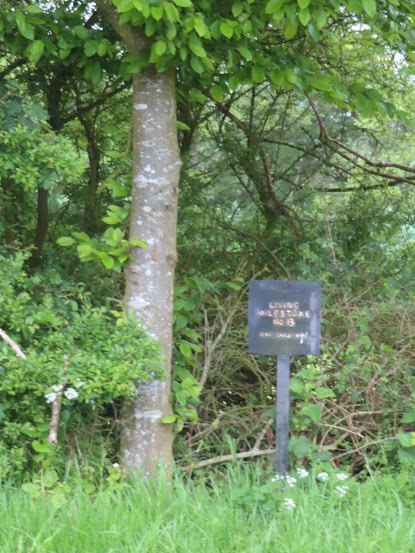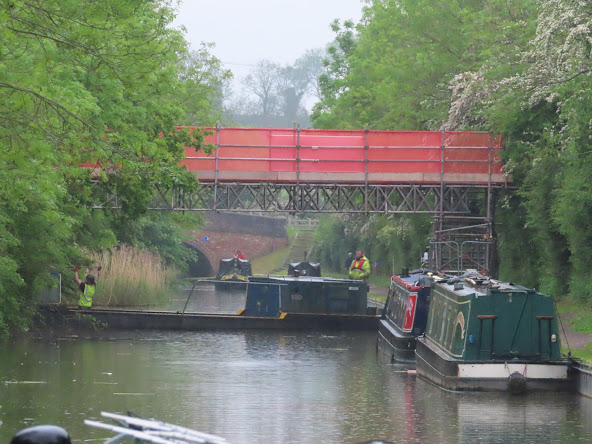It was quite misty this morning. I had slept like a log after laying down the new runner in the galley and dinette last night. It looks okay.
This field of wheat looks pretty good. The farmer must be relieved.
This summit pound looks like a river in places with the trees growing over the canal and reeds becoming well established. I have seen the towpath mowers out and about but not so much as previously. I have no objection to this as they seemed to want to make the banks like lawns. If you want it like that where you moor take some clippers and do the bit where you are. They do need to keep an eye on saplings growing though.
I have just noticed the blue engineering bricks on the edge of the bridge hole. I have just registered in my brain that they are obviously to same the brickwork from the old tow lines as they are harder than the red brick!!!
It was dry when we set off, but within ten minutes it started to drizzle and slowly picked up to light rain that stayed with us for the rest of the trip. It would have been miserable if there had been any more than the breath of wind that was with us. Some obviously felt it was cold, dank and miserable enough to light the boat stove. In fact through the day we spotted about 10 of them. It was 15 degs. outside.
There a few of these glamping pods in the field just after Yelvertoft. I did notice outside of the village, south of bridge 19 near the water point, there were some brick work remains on the off side. It seems there were at least 3 lime kilns here at the turn of the 1900's but they had gone off the map by 1950.
Not the best of hurriedly snatched photographs but this is one of the Old Union Canal Society milestone trees. The metal ones you see give the distance from Leicester. The original Grand Union used trees as mile markers and the Canal Society reinstated these in 1980. I'm not sure if they are all there still. I have seen a few but the plates aren't painted and looked after. These milepost mark the distance from Foxton, rather than Leicester.
There are several of these 'minimalist' bridges on the summit.
These bits of narrow boats are merging into the field over the years, with Crack's Hill in the background.
They have the footbridge almost up at Crick and the work boat was just passing the bits for the other stairs and only delayed us a few minutes.
You couldn't see the other end of the tunnel until well inside as it was so dull at the south end. We didn't meet anybody and as you may expect it was drier inside than out!
We were straight in at the top lock at Watford and it didn't take long to get to the bottom. As we were wet anyway we decided to stop for a quick top up of water before continuing on our way.
Helen gives the all clear at Hatton Junction and we make the st'bd turn towards Braunston.
A hurriedly taken picture of the weeping willow and the corner cottage before having to get us through the bridge hole.
No room on the moorings at the first bit, as you can see from the photo, but we carried on to past Bridge 7 and pulled in roughly where we had been on the way up. Of course as soon as the pins were in it stopped raining and the sun came out. I have actually really enjoyed today despite the wet. As I said if it had been windy it would have been a very cold difference.













2 comments:
The bridges you name minimalist are just as structural as others. The difference is that the ones which have railings at the sides show where the load bearing arch actually is. Those with brick sides camouflaged it.
Hi Mike,
I'm sure there is a reason for these bridges as others along the same stretch are the'usual type. There are some bridges on other canals that have collapsible rails and some that lean out a long way. I assume that these are to allow laden farm carts to pass over, may be with hay of cereals in the day. Maybe that is the same here and the railings have become fixed over the years. You can see that the actual load bearing arch is the same in both types of bridges. They would have made them all like this if they could have done as it would save on a fair few bricks.
Cheers for reading, Tony
Post a Comment